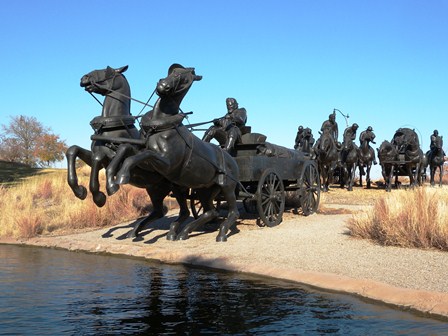» posted on Friday, November 9th, 2012 by Linda Lou Burton
The Promised Land
 Linda Burton posting from Oklahoma City, Oklahoma –Rome wasn’t built in a day, they say, but Oklahoma City almost was. And Guthrie too, Oklahoma’s first capital city. At high noon on April 22, 1889, the resident population of Guthrie was nothing; before sundown it was at least 10,000. In that time streets were laid out, town lots staked off, and steps taken toward the formation of a municipal government. The same thing was happening in Oklahoma City, which would later become the capital. Within a month of its beginnings, Oklahoma City had five banks and six newspapers. This phenomenal development is known as The Land Run, or, as some called it back then, Harrison’s Horserace. You see, President Benjamin Harrison announced on March 3 of that momentous year that almost two million acres of “unassigned lands” in Indian Territory would be opened for settlement on April 22. With
Linda Burton posting from Oklahoma City, Oklahoma –Rome wasn’t built in a day, they say, but Oklahoma City almost was. And Guthrie too, Oklahoma’s first capital city. At high noon on April 22, 1889, the resident population of Guthrie was nothing; before sundown it was at least 10,000. In that time streets were laid out, town lots staked off, and steps taken toward the formation of a municipal government. The same thing was happening in Oklahoma City, which would later become the capital. Within a month of its beginnings, Oklahoma City had five banks and six newspapers. This phenomenal development is known as The Land Run, or, as some called it back then, Harrison’s Horserace. You see, President Benjamin Harrison announced on March 3 of that momentous year that almost two million acres of “unassigned lands” in Indian Territory would be opened for settlement on April 22. With 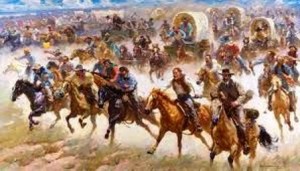 only seven weeks to prepare, land-hungry Americans quickly began to gather. By the appointed day more than 50,000 hopefuls were living in tent cities on all four sides of the territory, waiting for the signal to claim their land. Precisely at noon in one of the most dramatized and chaotic episodes in western history, the cannons were fired.
only seven weeks to prepare, land-hungry Americans quickly began to gather. By the appointed day more than 50,000 hopefuls were living in tent cities on all four sides of the territory, waiting for the signal to claim their land. Precisely at noon in one of the most dramatized and chaotic episodes in western history, the cannons were fired.
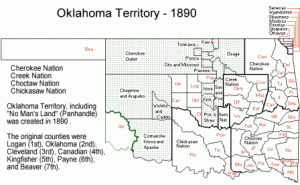 It had all the makings of a Gary Cooper movie. The land opened up to white settlement was in Indian Territory, initially considered unsuitable for white colonization. Beginning in 1817, Native Americans had been relocated from their traditional lands to this area; by the 1880’s it was the new home for Chickasaw, Choctaw, Cherokee, Creek, Cheyenne, Comanche, and Apache tribes. But a railroad had been built across the territory by then, and improved agricultural and ranching techniques led some Americans to pressure the US government to allow white settlement in the region. The Indian Appropriations Bill of 1889 was passed and signed into law; an amendment authorized President Harrison to open 2 million acres. That amendment, along with the Homestead Act signed by President Lincoln in 1862, allowed legal settlers to claim lots up to 160 acres in size. Thus began a long series of authorizations that eventually removed most of Indian Territory from Indian control; by 1905, white Americans owned most of the land. Two years later, the area once known as Indian Territory entered the Union as part of the new state of Oklahoma.
It had all the makings of a Gary Cooper movie. The land opened up to white settlement was in Indian Territory, initially considered unsuitable for white colonization. Beginning in 1817, Native Americans had been relocated from their traditional lands to this area; by the 1880’s it was the new home for Chickasaw, Choctaw, Cherokee, Creek, Cheyenne, Comanche, and Apache tribes. But a railroad had been built across the territory by then, and improved agricultural and ranching techniques led some Americans to pressure the US government to allow white settlement in the region. The Indian Appropriations Bill of 1889 was passed and signed into law; an amendment authorized President Harrison to open 2 million acres. That amendment, along with the Homestead Act signed by President Lincoln in 1862, allowed legal settlers to claim lots up to 160 acres in size. Thus began a long series of authorizations that eventually removed most of Indian Territory from Indian control; by 1905, white Americans owned most of the land. Two years later, the area once known as Indian Territory entered the Union as part of the new state of Oklahoma.
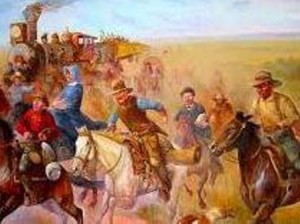 But back to April 22, 1889. As you might guess, everybody didn’t wait for the signal to begin. The railroad line that stretched across the territory had water towers and other requirements for steam rail operation located at intervals along the tracks that connected Arkansas and Texas. Two places – Oklahoma Station and Guthrie Station – seemed particularly well located for eventual urban development. In the months before the territory was opened, individuals and groups representing townsite companies scouted these locations and prepared town plans for these sites.
But back to April 22, 1889. As you might guess, everybody didn’t wait for the signal to begin. The railroad line that stretched across the territory had water towers and other requirements for steam rail operation located at intervals along the tracks that connected Arkansas and Texas. Two places – Oklahoma Station and Guthrie Station – seemed particularly well located for eventual urban development. In the months before the territory was opened, individuals and groups representing townsite companies scouted these locations and prepared town plans for these sites.
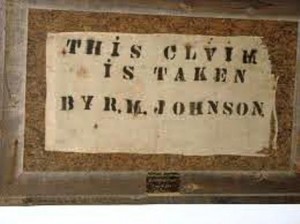 On Land Run Day, soldiers called for everyone to form a line on the borders of the territory; when the cannons fired at noon thousands of “Boomers” streamed into the territory in wagons, on horseback, and on foot; by nightfall they had staked thousands of claims on town quarter lots, or quarter-section farm plots. But this display of pioneer spirit and lust for land also was plagued by greed and fraud. Cases involving “Sooners” (people who entered the territory before the legal date and time) overloaded courts for years to come. Subsequent runs were conducted with more controls; eventually a lottery system was put into place.
On Land Run Day, soldiers called for everyone to form a line on the borders of the territory; when the cannons fired at noon thousands of “Boomers” streamed into the territory in wagons, on horseback, and on foot; by nightfall they had staked thousands of claims on town quarter lots, or quarter-section farm plots. But this display of pioneer spirit and lust for land also was plagued by greed and fraud. Cases involving “Sooners” (people who entered the territory before the legal date and time) overloaded courts for years to come. Subsequent runs were conducted with more controls; eventually a lottery system was put into place.
The April 22, 1889 Land Run involving 50,000 settlers was the first; eventually three million acres of Unassigned Lands were opened in Indian Territory.
- Land Run # 2, September 22, 1891. Land purchased from Iowa, Sac, Fox, Pottawatomie and Shawnee tribes was opened for settlement. Approximately 20,000 people claimed 6,097 160-acre homesteads.
- Land Run #3, April 19, 1892. Cheyenne and Arapaho lands were opened; about 25,000 people sought to claim over 400 lots. By the end of the first year there were more than 100 homes.
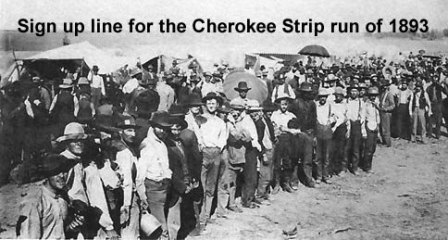 Land Run #4, September 16, 1893. Over 100,000 people came to claim land in the Cherokee Outlet; 40,000 quarter-sections were available. By the end of the day the cities of Enid, Perry, Alva and Woodward had risen out of virgin prairie.
Land Run #4, September 16, 1893. Over 100,000 people came to claim land in the Cherokee Outlet; 40,000 quarter-sections were available. By the end of the day the cities of Enid, Perry, Alva and Woodward had risen out of virgin prairie.- Land Run #5, May 3, 1895. The smallest and last Land Run was the Kickapoo opening. Of the 206,080 acres in the reservation, 183,440 acres were purchased by the US government and opened to settlers.
- Land Opening # 6, August 6, 1901. The Kiowa-Comanche-Apache and the Wichita-Caddo-Delaware Reservation lands were decided by a land lottery instead of a race. Over 160,000 people registered for the 13,000 quarter-sections that were available. An envelope contained a person’s name and address; the envelopes were numbered as they were drawn; each person could stake a claim according to the number on the envelope. This was the last large land opening in the present state of Oklahoma.
 By the time Oklahoma was admitted to the Union in 1907, Oklahoma City had surpassed Guthrie, the territorial capital, as the population center and commercial hub of the new state. With a population of 64,000, an efficient trolley system, a railway hub, and several large meat-packing plants and other industry, the city petitioned to become the new state capital. A vote was held, Oklahoma City won by a margin of 96,261 to 31,301, and the State Seal was moved from Guthrie to Oklahoma City on June 11, 1910.
By the time Oklahoma was admitted to the Union in 1907, Oklahoma City had surpassed Guthrie, the territorial capital, as the population center and commercial hub of the new state. With a population of 64,000, an efficient trolley system, a railway hub, and several large meat-packing plants and other industry, the city petitioned to become the new state capital. A vote was held, Oklahoma City won by a margin of 96,261 to 31,301, and the State Seal was moved from Guthrie to Oklahoma City on June 11, 1910.
 A monument designed to feature 45 figures of land-run participants, frozen in motion as they race to claim new homesteads, is now under construction in the Bricktown District of Oklahoma City. The first major pieces, a buckboard and two draft horses, were placed in April 2003. When completed, this piece of art will be one of the largest freestanding bronze sculptures in the world. It will span a distance of 365 feet in length by 36 feet in width and over 16 feet in height. The Land Run Monument begins with a soldier and a cannon, firing the shot to start the run. Twenty-four horses and riders, including a sun-bonneted woman riding sidesaddle, strain for position. A buckboard, two covered wagons, a buggy and a sulky represent some of the many vehicles used in the race. A dog races after a wagon, and a surprised rabbit watches from one side.
A monument designed to feature 45 figures of land-run participants, frozen in motion as they race to claim new homesteads, is now under construction in the Bricktown District of Oklahoma City. The first major pieces, a buckboard and two draft horses, were placed in April 2003. When completed, this piece of art will be one of the largest freestanding bronze sculptures in the world. It will span a distance of 365 feet in length by 36 feet in width and over 16 feet in height. The Land Run Monument begins with a soldier and a cannon, firing the shot to start the run. Twenty-four horses and riders, including a sun-bonneted woman riding sidesaddle, strain for position. A buckboard, two covered wagons, a buggy and a sulky represent some of the many vehicles used in the race. A dog races after a wagon, and a surprised rabbit watches from one side.
Land Run Monument http://www.okc.gov/landrun/index.html

